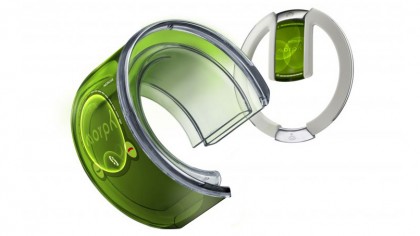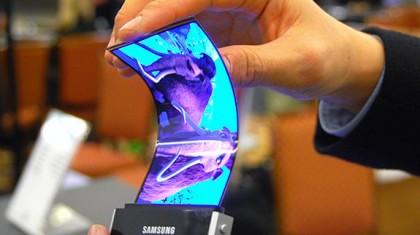Want to know when your phone will become your flexible friend?
Will pliable displays ever take off?
As the technology improves, smartphone forms will become a great deal more imaginative. Freed from the restrictions of rigidity, we could see a real drive toward designs that fold up to be truly portable, but also allow us to expand our smartphones to large tablet size for watching video.
The trend toward larger displays and hybrid smartphone/tablet devices indicates clear demand in the market already.
Interact in a new way
We could also find new ways to interact. The Nokia Kinetic, on show at Nokia World 2011, allowed users to flex the device in order to control it. You could scroll by twisting, or answer the phone by giving it a squeeze.
It's clever ideas like this that will capture the imagination of the public when a manufacturer delivers the first truly malleable phone - not just the fact that you can wrap it around your finger.

A similar idea has obviously occurred to Apple, as you can see from this patent application which discusses a system to detect "force exerted on a flexible display". A touchscreen that could determine the force you apply and react accordingly would be a great deal more intuitive to use.
It could also have major implications for apps and games. A harder strike on a virtual piano key, for example, could play a louder note - this is already possible, but flexible screens would give the user so much more relevant feedback.
The potential applications in wearable tech are also striking. Flexible displays could serve the burgeoning smartwatch industry, or be used in clothes themselves - imagine a display on your sleeve that bursts into life when you have an incoming call and prompts you to pop your earpiece in.
Get daily insight, inspiration and deals in your inbox
Sign up for breaking news, reviews, opinion, top tech deals, and more.
But we're getting way ahead of ourselves here.
So, what's actually happening now?
All major manufacturers of smartphones are working on flexible displays, in one form or another, for a multitude of devices. Samsung, LG, and Nokia have all shown off prototypes, where Sony, Phillips, Sharp, Toshiba, and others have revealed they're also working on the technology.
Even Apple has already filed patents in this area, showing that the race to release the first smartphone with a flexible display is clearly on - although the early pacesetters look to be LG and Samsung.

Samsung showed off its bendable OLED displays, dubbed Youm, at CES earlier this year, where LG Display followed up with something very similar at the Society for Information Display conference a few months later.
Both prototypes were crafted from thin plastic and based on OLED (organic light-emitting diode) technology - the same kind that's powered the high-performance displays in the Galaxy S2, S3 and S4.
Flexible LCD displays are possible, but OLED is preferable because it doesn't require a backlight. This enables thinner and lighter designs, critical for a bendable screen. OLED also offers deeper black levels, higher contrast ratios, and greater power efficiency.
The e-ink / flexible display combination is the most advanced example of this technology – and you're probably already using it today if you're one of the millions of ebook readers.
The Amazon Kindle, for instance, is packing a flexible display - that's what makes it so robust. However, bringing out a completely flexible ereader on the same scale would be too expensive, and require a flexible case, battery and processor too.
And while e-ink is good for the written word, it's not use in smartphones as it can't handle HD video. It even struggles to reproduce colour to the same degree as a Super AMOLED or LCD display.
The general consensus is summed up in a recent IHS report into the possible state of the flexible display market: "We predict OLEDs will be the leading flexible display technology during every year for the foreseeable future."